Cockroach Facts, Identification, and Control
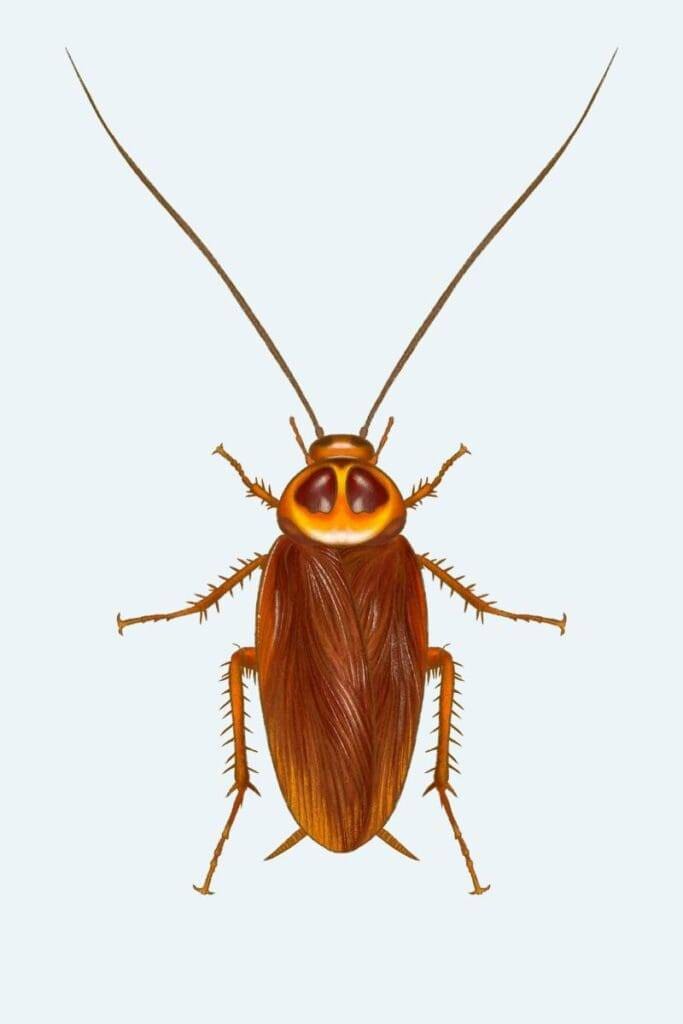
Cockroaches are the most common insect pests in the Northeast, infesting homes, food service establishments and other structures. They are large, omnivorous insects capable of transmitting disease, which in turn, can cause food poisoning. Cockroaches are also the second most common allergen for people, the first being house dust.
In New York City, approximately 1 in 5 households report seeing cockroaches in their homes each year (compared to 1 in 9 households nationally), according to data we reviewed from the American Housing Survey.

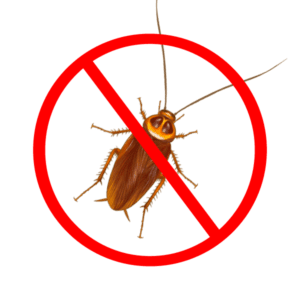
Cockroach Control in NYC
Need help getting rid of cockroaches in your home or business? At MMPC, we specialize in providing effective, long-term solutions for stubborn infestations.
Facts
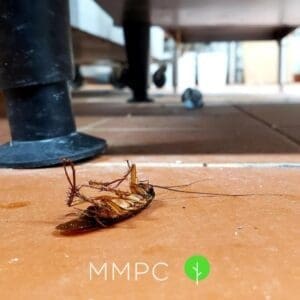
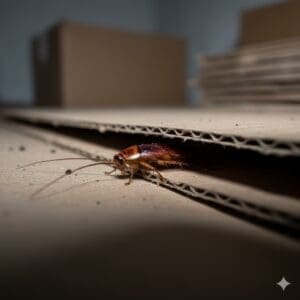
Risks
The presence of cockroaches is not just a nuisance; it is a significant public health issue.
Pathogen Transmission
Cockroaches are mechanical vectors of disease. They carry pathogens on their bodies, legs, and antennae as they travel between contaminated areas to sanitary ones. These include:
- Salmonella (food poisoning)
- E. coli
- Staphylococcus and Streptococcus species
The transmission risk is compounded by their excretions. Bacteria ingested by a cockroach can survive in its digestive system for months.1 These are passed through its droppings, leading to surface and food contamination.
Indoor Allergens
Cockroaches are one of the most common source of indoor allergens.
The allergens are proteins found in their feces, saliva, and shed exoskeletons. These break down into microscopic particles and become airborne, mixing with household dust. When inhaled, it triggers an immune response that leads to allergic reactions and asthma attacks.
Approximately 63% of homes in the U.S. contain detectable levels of cockroach allergens,2 and 26% of the U.S. population is sensitized (allergic).3
Biology
The persistence of cockroaches is a direct result of highly evolved biological mechanisms that allow for rapid reproduction, extreme survivability, and behaviors that exploit human structures.
Behavior
Cockroaches are primarily nocturnal, emerging at night to forage for food and water. When competition for food gets fierce, weaker individuals may venture out during daylight hours; this is usually a sign of a severe infestation.
During the day, they exhibit a strong survival behavior called thigmotaxis—an innate preference for having their bodies in contact with surfaces, or more simply, a “preference for tight spaces”. They spend about 75% of their lives hidden in these dark, narrow cracks and crevices. This behavior is why they are so hard to reach and why many “bug bomb” style foggers fail.
Reproduction
Cockroaches have a three-stage life cycle: egg, nymph, and adult.
A key reproductive structure for cockroaches is the ootheca, a protective, pillow-shaped or bean-shaped egg capsule produced by the female. Depending on the species, a single ootheca can contain between 12 and 50 eggs.4
Newly hatched nymphs (immature “baby” cockroaches) are small, wingless, and behave differently than adults. They tend to stay aggregated deep within their harborage and do not forage far. This behavior is a critical factor in control failures, as pesticide sprays applied to visible surfaces like baseboards or countertops will miss a large part of the population—the nymphs—which are hidden within walls and crevices.
Survivability
Cockroaches are notoriously hard to kill by starvation or injury.
- Food and Water: A cockroach can live for approximately one month without any food.5 However, they are far more dependent on water and can only survive for about one week without it. This makes moisture their greatest vulnerability.
- Without a Head: A cockroach can live for up to one week without its head. They do not have a pressurized circulatory system, so they don’t bleed out. They breathe through small openings in their body segments (spiracles), not their mouth. The roach eventually dies from dehydration because it can no longer drink water.
Conducive Conditions
An infestation is sustained by an environment that provides three basic requirements: food, water, and shelter. Cockroaches, particularly the common domestic species, prefer warm, moist places.
Food
Cockroaches prefer starchy and sugary materials. Common food sources include crumbs, grease, unrinsed bottles, pet food, and garbage. However, they are capable of surviving on a much wider diet, including non-food items like the sizing on book bindings, glue, paper products, and even soap scum, toothpaste residue, and hair found in bathrooms.
Water
This is the most critical attractant. Any source of moisture can sustain a population. Common sources include leaky pipes (especially under sinks), dripping faucets, condensation from showers or on cold water pipes, clogged drains, and pet water bowls.
Shelter
Cockroaches seek tight, dark, and preferably moist cracks and crevices. Prime harborage areas in a kitchen include:
- Under and behind appliances (refrigerators, stoves, dishwashers)
- Inside and under cabinets, especially in the “dead space” between the sink and the wall
- In wall voids and behind electrical outlets
Cardboard
Cardboard is a significant and often-overlooked factor in cockroach infestations. It is uniquely attractive to them because it provides all three elements of shelter, food, and moisture.
- The corrugated structure offers dark, narrow, protected channels that satisfies their thigmotactic preferences.
- Cockroaches consume the cellulose of the cardboard itself, as well as the starch-based glues that hold the boxes together.
- Cardboard is a porous material that readily absorbs ambient humidity from the air.
Because of this, cardboard boxes (from deliveries, groceries, or moving) often serve as a primary vector for introducing an infestation, as cockroaches and their eggs hidden within the corrugation can be transported directly into a home.
Identification
What Do Cockroaches Look Like?
Cockroaches have flattened oval bodies with six spiny legs and long, threadlike antennae. The common species are light brown or reddish-brown.
Key ID Features
- Pronotum: A prominent, shield-shaped plate that covers the head when viewed from above. Markings on the pronotum are the primary way to identify different species.
- Antennae: Two very long, slender antennae (often the length of the body) that act as “feelers” for touch and smell.
- Legs: Six long legs covered with spines.
- Wings: Most adult cockroaches have wings lying flat on their back.
- Cerci: Two small, stubby appendages at the very end of the abdomen used to sense air movements (like a predator approaching), triggering the roach’s rapid escape response.
Cockroach Nymphs
Baby cockroaches, or nymphs, look like smaller, wingless versions of the adults. Their appearance can differ from adults; for instance, baby German roaches are dark with a single light stripe.
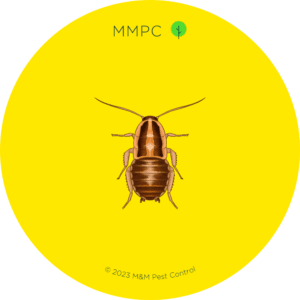
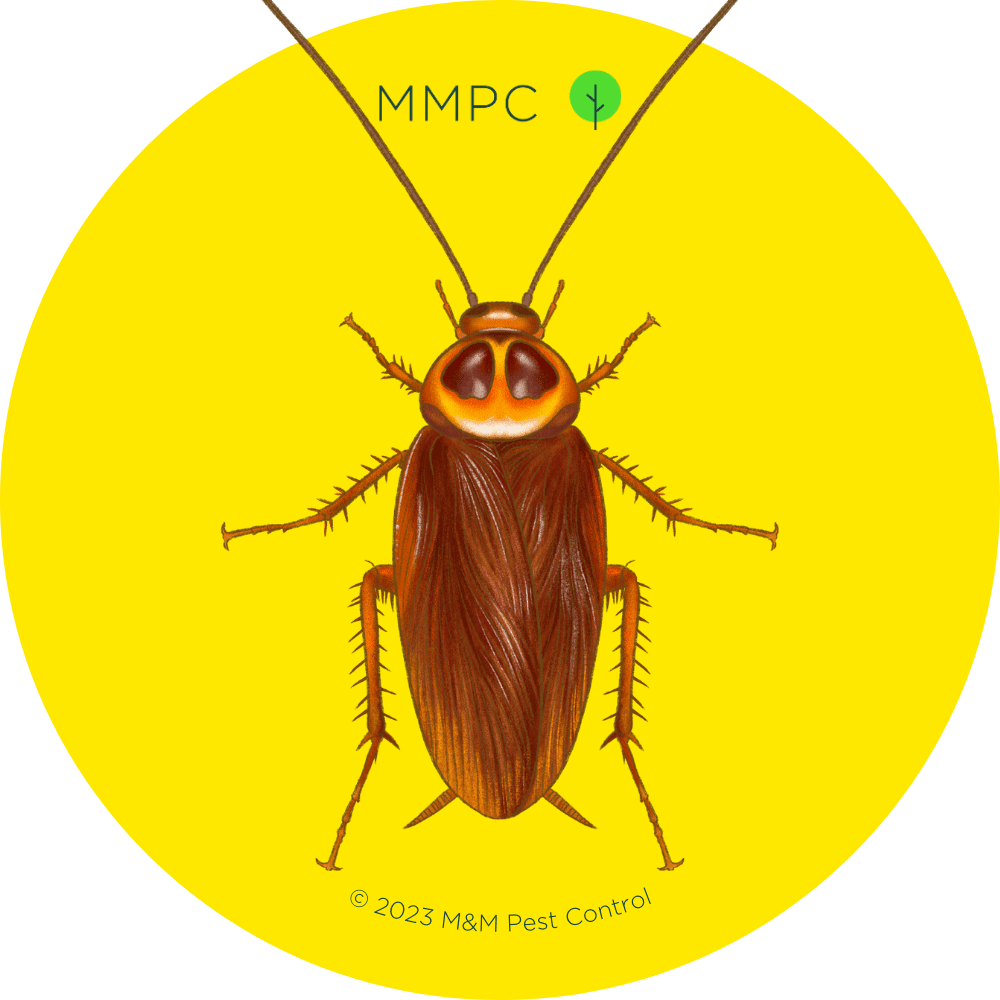
American Cockroach
Periplaneta americana
These are the large, reddish-brown roaches found in homes. Adults are capable of short flights, but only when temperatures are high (above 85°F).
- Size: The largest of the common pest roaches, measuring 1 to 2 inches (29–53 mm) long
- Color: Reddish-brown
- Key ID Features: A pale yellow “figure-eight” pattern on the pronotum
More About American Cockroaches
- Infestations are usually associated with moisture or plumbing problems.
- They prefers warm, damp environments and are commonly found in sewers, steam heat tunnels, boiler rooms, basements, and around drains.
- They often enter structures from the outside or by traveling up through sewer pipes

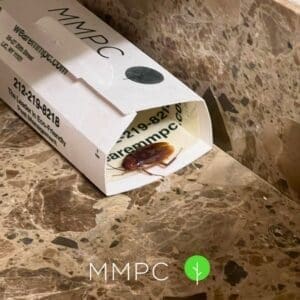
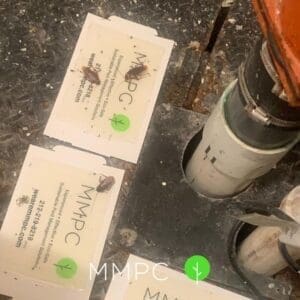
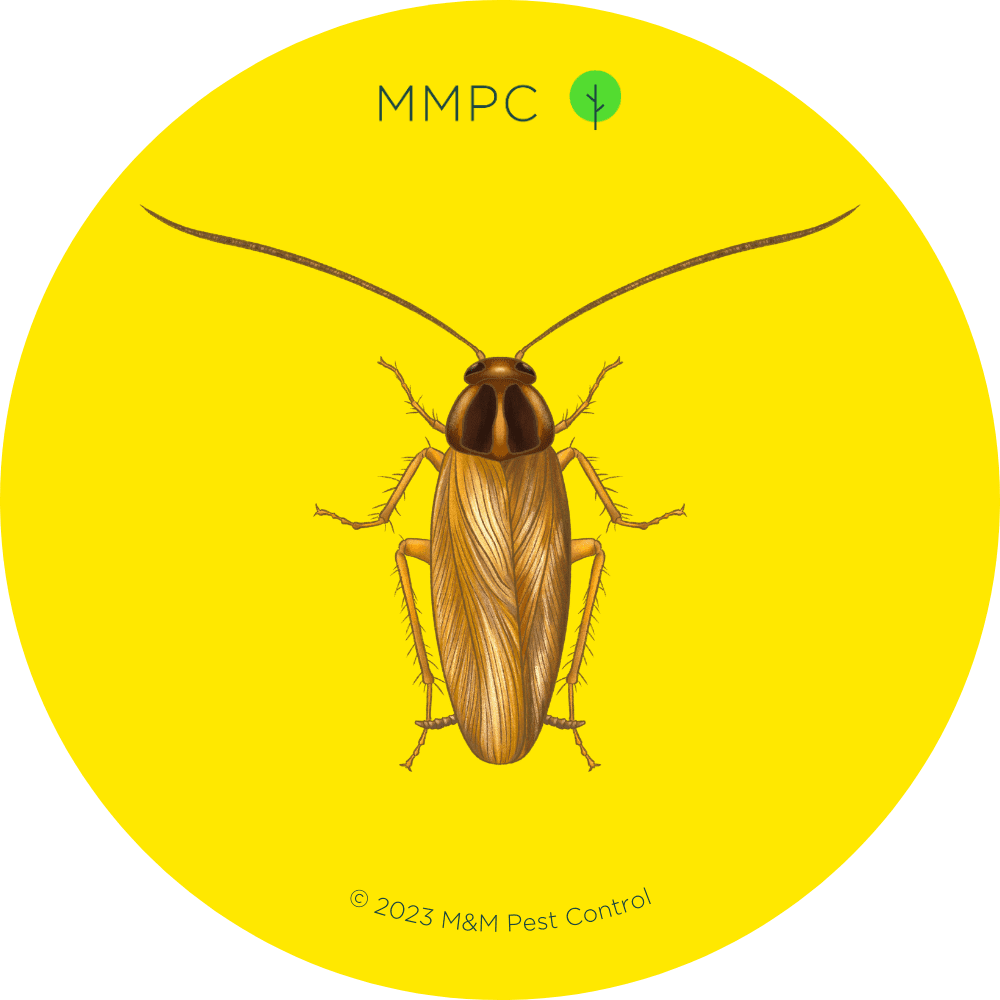
German Cockroach
Blattella germanica
German cockroaches are small, light brown roaches that can squeeze through gaps as narrow as 1/16″.
- Size: Small, about 1/2 to 5/8 of an inch (13–16 mm) long
- Color: Light brown or tan
- Key ID Features: Two dark, parallel stripes running down the pronotum
More About German Cockroaches
- This is the most common household pest cockroach worldwide.
- They reproduce extremely quickly. A single female and her offspring can lead to a population of over 300,000 in one year.
- They are an indoor-only species. Infestations are common in cluttered areas or where sanitation is poor.
- They prefer warm, humid environments are are almost exclusively found in kitchens and bathrooms, close to food and moisture.
- They move to new locations by hitchhiking in cardboard boxes, grocery bags, and other household items.
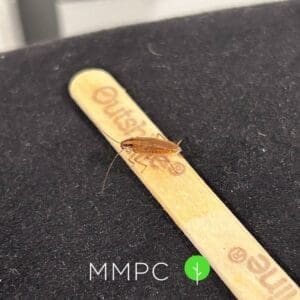
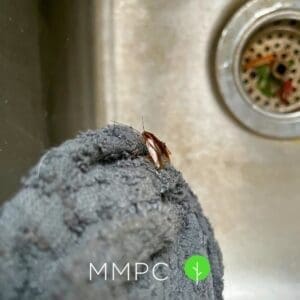
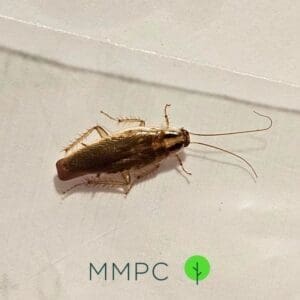
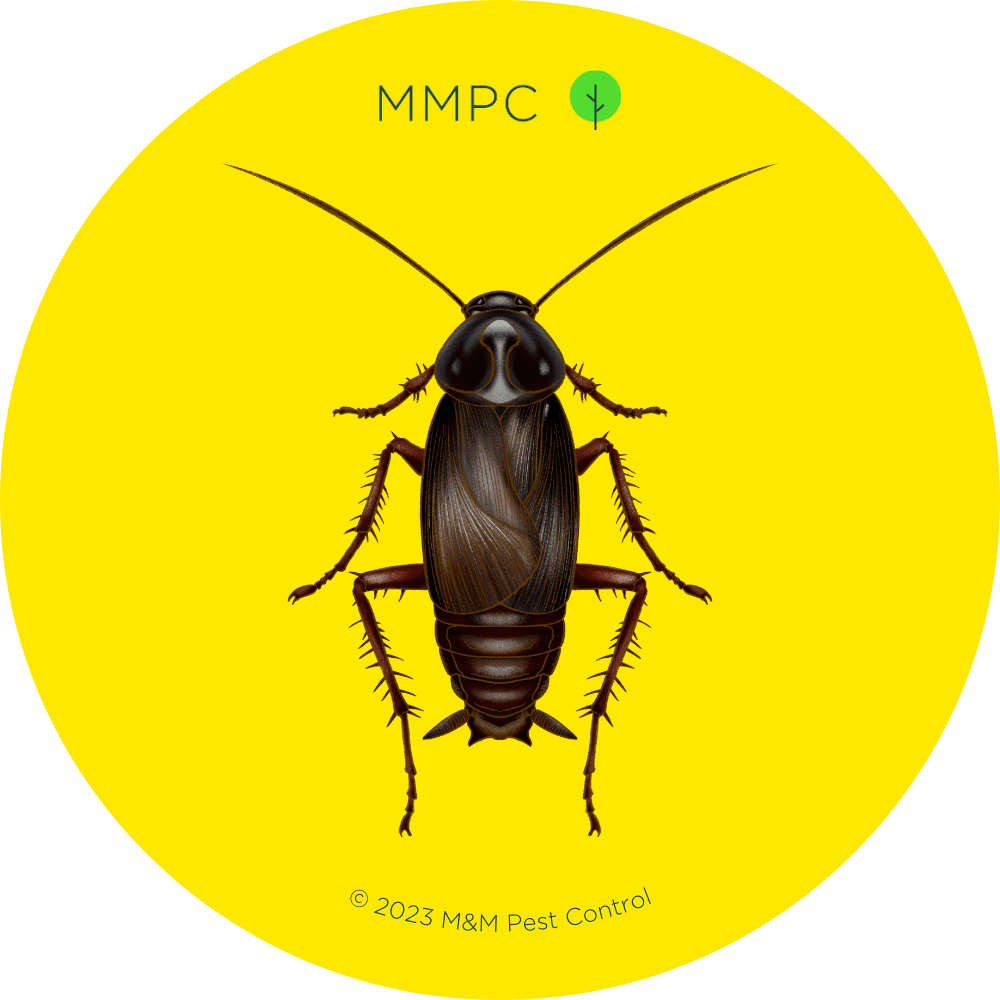
Oriental Cockroach
Blatta orientalis
Oriental cockroaches have uniform, glossy black bodies. They are known for having a notably strong, musty, or “pungent” odor. Large infestations smell awful.
- Size: Large, about 1 to 1.25 inches (18–29 mm) long.
- Color: Shiny, dark reddish-brown to almost black
- Key ID Features: The wings are a key identifier. Females have only small, non-functional wing stubs, while males have wings that are shorter than their body. Neither sex can fly.
More About Oriental Cockroaches
- They prefer cool, dark, and very damp, ground-level areas, such as basements, cellars, crawl spaces, garages, in and around floor drains, and in water meter boxes.
- Outdoors, they live in mulch and leaves and can survive temperate winters.
- These roaches only produce one generation a year, and newly-hatched nymphs take 18 months to reach adulthood.
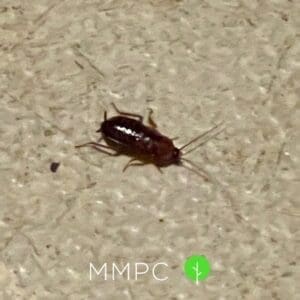
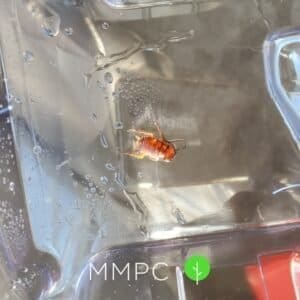
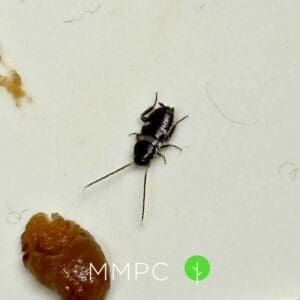
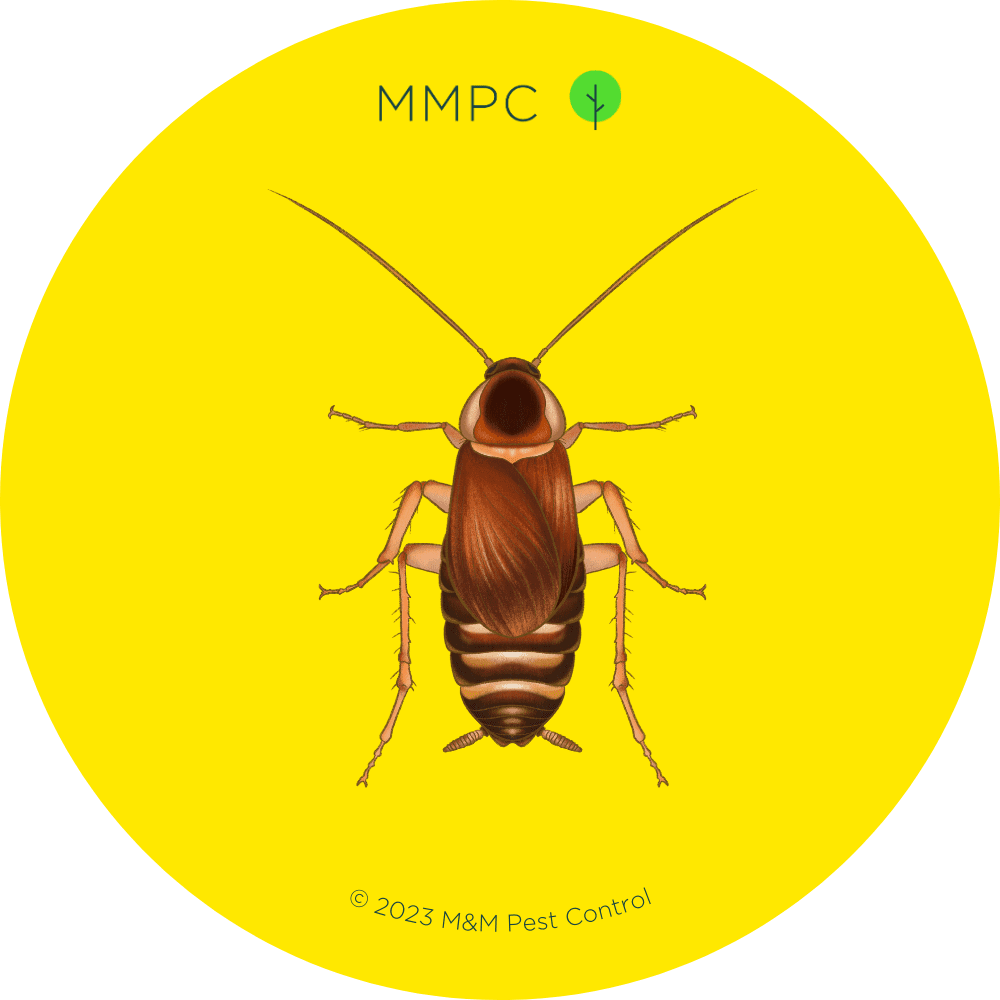
Brown-Banded Cockroach
Supella longipalpa
Unlike other species, brown-banded cockroaches prefer warm and dry conditions. They scatter throughout living rooms, bedrooms, closets, and offices, usually seeking elevated hiding spots.
- Size: Small, about 1/2 to 5/8 of an inch (10–14 mm) long
- Color: Brown
- Key ID Features: Named for the two light-colored, horizontal bands (stripes) that run across their wings and abdomen
More About Brown-Banded Cockroaches
- Because of their dry-environment preference, they are known to feed on non-food items with starch, such as wallpaper paste, book bindings, glue, and stamps.
- The males have long wings extending past their body tip and can manage short flights, while the females have short wings and cannot fly.
- One female can produce up to 600 young in her lifetime.
- Control can be difficult because infestation are usually not centralized (they may be hiding in every room of the house).
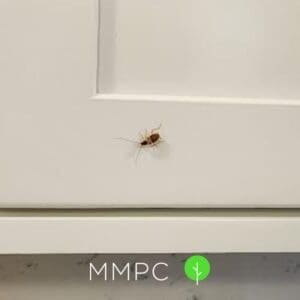
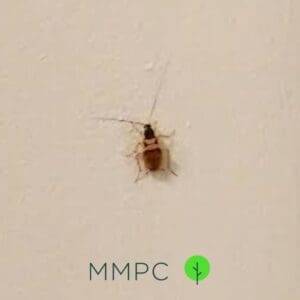
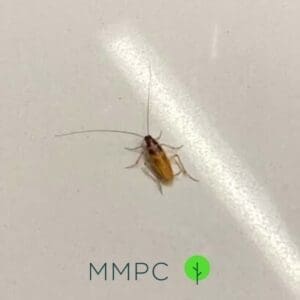
Control
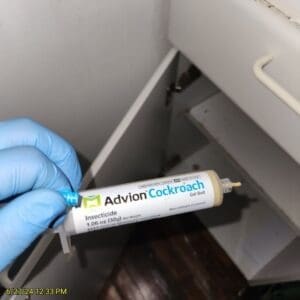
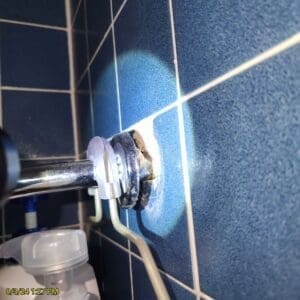
DIY Methods
An effective DIY approach requires using cockroach biology against them, which is why some of the most popular products fail.
Gel Baits and Bait Stations
These are the most effective DIY chemical controls. They combine a food attractant with a slow-acting, non-repellent insecticide. Roaches eat the bait and carry it back to their harborage. This allows the poison to spread to other roaches, wiping out 90–95% of populations within days.
Boric Acid (Dust)
This is an effective, long-lasting insecticidal dust. Boric acid sticks to their bodies when they crawl through treated areas. Since roaches constantly clean their legs and antennae, they swallow the powder, which attacks their digestive and nervous systems. It’s ideal for treating inaccessible, undisturbed areas behind outlets, under appliances, and in wall voids.
Diatomaceous Earth (DE)
This is another effective insecticidal dust. It is made of fossilized diatoms with microscopic sharp edges, which scratches the waxy outer layer of the roach’s exoskeleton and causes them to lose moisture and die from dehydration.
Important Safety Note: Only use “pesticide grade” (often labeled “food grade”) DE. “Pool grade” DE is not the same and is a severe respiratory hazard.
Ineffective: Total-Release Foggers (“Bug Bombs”)
These are not recommended and largely ineffective.
- The aerosol mist settles on exposed surfaces but cannot penetrate narrow cracks and wall voids where most roaches hide.
- The active ingredients are often repellent, which scatters the infestation, driving roaches deeper into walls or into new, previously un-infested areas.
- They leave toxic residue on human-contact surfaces and the propellants are highly flammable.
Prevention
You can prevent cockroach infestations by removing attractants and conducive conditions (food, water, and shelter).
Sanitation
- Store all food (including pet food, cereal, and grains) in hard, insect-proof containers (glass, metal, or thick plastic) with tight-fitting lids. Roaches can chew through cardboard and thin plastic.
- Clean up all crumbs and spills immediately.
- Don’t leave dirty dishes in the sink overnight.
- Keep garbage in a container with a tight-fitting lid and empty it daily.
- Remove clutter, especially stacks of paper, magazines, and cardboard boxes.
Moisture Control
- Fix all leaky pipes and dripping faucets immediately.
- Drain sinks and tubs after use and keep all areas clean and dry.
- Run bathroom fans or open a window after showering to keep moisture from building up.
Exclusion
- Use caulk to seal cracks and crevices. Pay special attention to gaps along baseboards, behind sinks, and inside cabinets.
- Seal all openings around pipes (under sinks, behind toilets) and where utility lines enter the home.
- Check and maintain unused sinks. When P-traps dry out, it creates a direct route for American cockroaches to travel from the sewers into your home.
- Inspect everything before bringing it inside. Roaches can hitchhike in cardboard boxes, electronics, old appliances, etc.
Professional Services
While a small infestation can be managed with DIY methods, professional intervention is often necessary.
When to Call a Professional
- You see cockroaches during the daytime (a sign of a severe infestation).
- You live in a multi-unit dwelling (like an apartment or condo). In this case, DIY efforts will almost always fail, as roaches will simply migrate from untreated neighboring units. Control requires a coordinated, building-wide effort.
- DIY efforts (baits, dusts, and sanitation) fail to eliminate the problem after a few weeks.
Integrated Pest Management (IPM)
A professional does not just “spray” for roaches.
At MMPC, we an IPM approach to provide effective, long-lasting solutions for cockroach infestations. Our proven process involves both assessment and treatment steps.
- Assessment: Identifying the species, locating harborages and entry points, and monitoring with sticky traps
- Treatment: Combining sanitation and exclusion with targeted, professional-grade baits and dusts.
Insect Growth Regulators (IGRs)
A key tool in our professional toolkit is the Insect Growth Regulator (IGR). These mimic the insect’s own juvenile hormones, disrupting the cockroach life cycle by preventing nymphs from successfully molting into reproductive adults.
It’s important to note that IGRs are a long-term, strategic tool, not a “quick fix” or fast-acting poison.
FAQs
Do Cockroaches Bite?
Most of the time, no. They’ve got chewing mouthparts, but they are not strong enough to penetrate human skin. In extreme infestations, starving roaches have been reported to nibble on dead skin, fingernails, or eyelashes while someone sleeps, but this is exceptionally rare.
Read More: Do Cockroaches Bite?
Do Cockroaches Fly?
German and Oriental cockroaches can’t fly. Americans and brown-banded species are capable of short, gliding flights when it’s really hot (above 85°F), but it’s more controlled falling than actual flying.
Read More: Do Cockroaches Fly?
What Do Baby Cockroaches Look Like?
Cockroach nymphs look like small, wingless versions of adults, often lighter in color. The body shape stays the same across all life stages; same proportions, just smaller.
Read More: What Do Baby Cockroaches Look Like?
- Cockroaches | Better Health Channel, accessed November 4, 2025, https://www.betterhealth.vic.gov.au/health/healthyliving/cockroaches ↩︎
- Cohn, R. D., Arbes, S. J., Jr, Jaramillo, R., Reid, L. H., & Zeldin, D. C. (2006). National prevalence and exposure risk for cockroach allergen in U.S. households. Environmental health perspectives, 114(4), 522–526. https://doi.org/10.1289/ehp.8561 ↩︎
- Cockroaches, Bed Bugs, and Public Health – CHFS.ky.gov, accessed November 4, 2025, https://www.chfs.ky.gov/agencies/dph/dpqi/cdpb/Documents/DeVries.pdf ↩︎
- Cockroaches – Illinois Department of Public Health, accessed November 4, 2025, https://dph.illinois.gov/topics-services/environmental-health-protection/structural-pest-control/cockroaches.html ↩︎
- How Long Do Cockroaches Live? – Ehrlich Pest Control, accessed November 4, 2025, https://www.jcehrlich.com/pest-insights/cockroaches/how-long-do-cockroaches-live ↩︎


